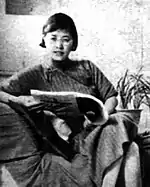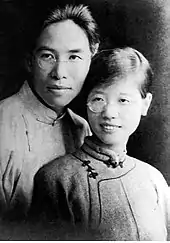Ling Shuhua
Ling Shuhua (Chinese: 凌叔华; 1904–1990),[nb 1] also known as Su-hua Ling Chen after her marriage, was a Chinese modernist writer and painter[3] whose short stories became popular during the 1920s and 1930s. Her work continues to be widely anthologized today.[4]
Ling Shuhua | |
|---|---|
 | |
| Born | 1904 Beijing |
| Died | 1990 |
| Occupation | Writer |
| Nationality | Chinese |
Biography

Ling Shuhua was born Ling Ruitang in Beijing.[2] Shuhua was the daughter of the fourth wife of a high ranking Qing official from the southern province of Canton, who later served as the mayor of Beijing.
Soon after graduating, she married Chen Yuan, the founder of the important May Fourth Movement journal Contemporary Review. In 1927, the couple moved to Hubei so that Chen could teach at Wuhan University.
And in 1924, Ling met Chen Yuan in Beijing. At the time, Chen yuan was an English professor at Peking University and an influential literary critic. The year after they met, Chen rose to fame in a debate with lu Xun, a famous Chinese writer. Through Chen Yuan, Ling shuhua got to know many famous writers of the time, such as Shen Congwen.[5]
While at Wuhan University, Ling met Julian Bell in 1935 when he was temporarily an English teacher in China.[6] During his short stay there until 1937, they had a love affair while Ling was still married.[7] In 1999, Hong Ying published K: The Art of Love, a book based on their relationship that was later banned.
Through her connections with Bell, she was able to start a correspondence with Virginia Woolf, Bell's aunt. The two writers maintained their correspondence between 1938 and 1941. Woolf agreed to read drafts of the memoirs Ling which had begun writing. This manuscript was published in 1953, with the name Ancient Melodies. Ling dedicated this work to Virginia Woolf and Vita Sackville-West, whom she met in England in the 1940s.
She moved again to London in 1947, where she became a Chinese representative for UNESCO. She mostly remained in London except for 1956 when she taught at Nanyang University in Singapore. She moved back to China shortly before her death.[8]
Shuhua had a daughter named Hsiao-ying Chen.[7]
Ling also practiced calligraphy and was a painter of the scholarly tradition. She also studied painting at the court of the Empress Dowager Cixi, where she became an apprentice to a teacher . Some of her Chinese books have been published with her own inked paintings on the cover.[9] In the narrative of Ling shuhua's grandson, her great-aunt ling Shuhua is a painter. But at the same time she found Ling Shuhua to be an outstanding writer of Chinese modernist fiction in the 1920s.
Temple of Flowers
Published in 1928, Temple of Flowers was Ling's first book of fiction. It includes some of her most famous short stories, including "The Embroidered Pillow" and "On the Eve of the Mid-Autumn Festival".
Writing style and career
She often wrote on "feminine" themes of domesticity.She is also known as a writer of the new boudoir style . Strong feminism is dominant in her creation and dominates her creative thinking . Sensitive social and political issues often arise in her work . Her work was also criticized . After the contemporary feminism re-examines Ling Shuhua's works , they also make a conclusion of the phenomenon of denying Ling Shuhua's works . Most of the reasons come from sexism and morality . Ling shuhua's father also revealed that " he doesn't think girls need to learn much " . It also expresses the role and social status that women played in the family at that time .[10]
Ling shuhua has many famous short stories " The Temple of Flowers " , " Women " , " Little Brothers " and his collection of essays " Love mountain Dream " . And Ling Shuhua is best known for her autobiography , written in China in 1930 , Anicent Melodies . She was no ordinary writer , and was known abroad as " She was like speaking with clipped tongue " as she used her " special writing style " in writing English books .
In her 1988 article Moral Bargain: Reading Three Stories of Ling Shuhua, Zhou Lei mentioned the reasons why Ling chose such a subject. Under the social atmosphere at that time, most women were buried with patriarchy in the process of growing up, and they needed to obey their fathers' decisions. It also leaves in mind that women need to make sacrifices at home. Even though Ling Shuhua was already a little famous in the literary world at that time, she never showed her father what she had written, because she knew that her father did not like her writing in vernacular Chinese, which was also a manifestation of patriarchy.[11]
Since his father was a Confucian scholar , Ling shuhua also learned classical Chinese as a child . Most of her writing , though , uses vernacular Chinese that her father dislikes . But what is interesting is that she did not give up the classical culture she had studied for many years because of learning the vernacular Chinese , and this writing feature is especially evident in her White Birch . The book has a strong Chinese classical atmosphere , and readers appreciate Ling Shuhua because of this work . But even such excellent works will be personified and feminized because the author is a woman.[12]
Ling is best known for her autobiography , "Ancient Melodies" , in which her distinctive writing style and " Chinese-style " English was discovered by Virginia Woolf before they were published . Ling Shuhua's English writing grammar is difficult for foreigners to understand but very distinctive . In Woolf's letter to Ling , Woolf suggested that Ling continue to insist on her own free writing style , which should approximate the Chinese language in general meaning . Only in this way can the article retain as much Chinese flavor as possible . At Woolf's suggestion , Ling completed his autobiography .[13]
Because her short stories first appeared in western journals, Shuhua is often associated with the westernized literary aesthetic. Her Chinese critics have called her the "Katherine Mansfield of China".[4] Ling was aware of Mansfield's fiction and cited it as an influence on her work.[14]
Vita Sackville-West, who wrote the introduction for Ling's Ancient Melodies, recommended the book for its "Arabian Nights quality".[15] When the book was published, it received immediate acclaim in the west. J.B. Priestly wrote an essay on Ancient Melodies, calling it "the book of the year".[9]
Criticisms
In her time, Shuhua was called a writer of the Xin guixiu pai (The New Boudoir School), suggesting she was conservative in her choice of subject matter and less defiant in her criticism of tradition.[16] Moreover, by exposing and criticizing the oppression of men's power implied in her works, she broke the contract that bound women, which was transformed into the subversion of men's power, and also defended the unfair treatment and status of women in the society at that time.[17]
Publications
| Library resources about Ling Shuhua |
| By Ling Shuhua |
|---|
- Temple of Flowers (1928)
- Women (1930)
- Two Little Brothers (1935)
- Ancient Melodies (1953)
References
- Helen Tierney (1999). Women's Studies Encyclopedia: A-F. Greenwood Publishing Group. pp. 251–. ISBN 978-0-313-31071-3. Retrieved 31 December 2012.
- Lily Xiao Hong Lee; Clara Wing-chung Ho (2003). 中國婦女傳記詞典: The Twentieth Century, 1912-2000. M.E. Sharpe. p. 351. ISBN 978-0-7656-0798-0. Retrieved 31 December 2012.
- Patricia Ondek Laurence (2003). Lily Briscoe's Chinese Eyes: Bloomsbury, Modernism, and China. Univ of South Carolina Press. p. 1. ISBN 978-1-57003-505-0. Retrieved 31 December 2012.
- Professor Amy D Dooling; Kristina M. Torgeson (1998). Writing Women in Modern China: An Anthology of Women's Literature from the Early Twentieth Century. Columbia University Press. p. 177. ISBN 978-0-231-10701-3. Retrieved 31 December 2012.
- Dooling, Amy D. "Ling Shuhua (25 March 1900-22 May 1990)." Chinese Fiction Writers, 1900-1949, edited by Thomas Moran, vol. 328, Gale, 2007, pp. 95-103. Dictionary of Literary Biography Vol. 328. Gale Literature: Dictionary of Literary Biography, https://link-gale-com.login.ezproxy.library.ualberta.ca/apps/doc/PLOVWT493285982/DLBC?u=edmo69826&sid=DLBC&xid=43559d9d. Accessed 15 Dec. 2020.
- Sasha Su-Ling Welland (1 September 2007). A Thousand Miles of Dreams: The Journeys of Two Chinese Sisters. Rowman & Littlefield. p. 7. ISBN 978-0-7425-5314-9. Retrieved 31 December 2012.
- Patricia Ondek Laurence (2003). Lily Briscoe's Chinese Eyes: Bloomsbury, Modernism, and China. Univ of South Carolina Press. p. 63. ISBN 978-1-57003-505-0. Retrieved 31 December 2012.
- Michael Sullivan (2006). Modern Chinese Artists: A Biographical Dictionary. University of California Press. pp. 97–. ISBN 978-0-520-24449-8. Retrieved 31 December 2012.
- Shumei Shi (2001). The Lure of the Modern: Writing Modernism in Semicolonial China, 1917-1937. University of California Press. pp. 219–. ISBN 978-0-520-22064-5. Retrieved 31 December 2012.
- Yan, Jason. ""But the sound that is left is still cold and clear": Writing Transnational Chineseness in Ling Shuhua's Ancient Melodies". Cite journal requires
|journal=(help) - Zhang, Xiaoquan Raphael (2012). "Negotiations and Transactions Across Boundaries in Ling Shuhua's English Memoirs: Negotiations and Transactions Across Boundaries in Ling Shuhua's English Memoirs". Comparative Literature Studies.
- Barlow, Tani E. (1993). Gender Politics in Modern China: Writing and Feminism. Duke University Press. pp. 90–103. ISBN 978-0-8223-1389-2.
- HUI, WAN (2016). "PRIVATE AND COMMON GROUND: THE WORK OF LING SHUHUA AND VIRGINIA WOOLF IN THE LATE 1930S" (PDF). Cite journal requires
|journal=(help) - Bonnie S. McDougall; Kam Louie (1 December 1999). The Literature of China in the Twentieh Century. Columbia University Press. pp. 123–. ISBN 978-0-231-11085-3. Retrieved 31 December 2012.
- Sasha Su-Ling Welland (1 September 2007). A Thousand Miles of Dreams: The Journeys of Two Chinese Sisters. Rowman & Littlefield. p. 19. ISBN 978-0-7425-5314-9. Retrieved 31 December 2012.
- Tze-Lan D. Sang (15 January 2003). The Emerging Lesbian: Female Same-Sex Desire in Modern China. University of Chicago Press. pp. 150–. ISBN 978-0-226-73480-4. Retrieved 31 December 2012.
- Barlow, Tani E. (1993). Gender Politics in Modern China: Writing and Feminism. Duke University Press. ISBN 978-0-8223-1389-2.